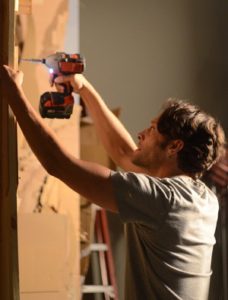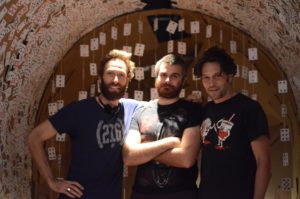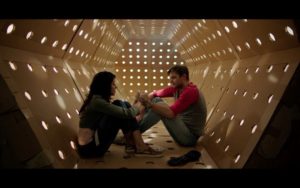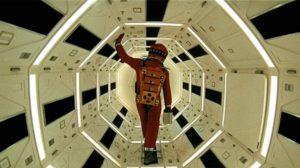Interview| John Charles Meyer
This interview is part of an ongoing series covering films appearing in the 2017 Calgary Underground Film Festival, published simultaneously with www.danielmelvilljones.com.
Dave Made a Maze is your average story of a frustrated creative who builds a giant maze in his living room that comes alive and takes on a life of it’s own. If you watch it, you’ll be blown away by perhaps the most truly inventive set design we’ve see in a long time. To learn more about the production of the film, I spoke on the phone with producer John Charles Meyer. He had plenty of stories to share.
The project required a lot of cardboard.
Initially they were asking their friends to save scraps, which were “grease stained and folded in weird ways.” So when they found a donor who gave them “an entire 14 foot box truck full to the ceiling of uniform cardboard that was going to be discarded,” John was thrilled. This cardboard was “gorgeous stuff” and “we thought there was no way in hell we were going to need more than that.” But a mere three weeks into production, the art director confronted John. They had run out of cardboard. So John started knocking on neighborhood doors. “Right next door to where we were shooting [was] Eon Musk’s company Solar City. I stuck my head in and said… “I’m shooting a movie next door and we need cardboard. Any chance that you throw out large quantities of cardboard?” They showed John a massive dumpster out back filled with nothing but cardboard for recycling and told him we was welcome to it any day. “For the rest of the production, every single day of mine started with me dumpster diving at Solar City for additional cardboard for my art department.”
An unusual cardboard donation inspired one of their most beautiful scenes.
The script described the rooms in detail. From there, the art department “put together a production bible of sketches, filled with images of each room and the different ways that light might enter each room.” But one day they received a large stack of cardboard sheets perforated with holes. “Originally we looked at it and thought, “What the hell are we going to use cardboard with holes for?” You can’t make walls out of it and you can see through it.” But that limitation inspired them to create a beautifully lit hexagonal corridor, which “we affectionately refer to as the Kubrick Corridor. It’s really one of the most gorgeous shots in the film and is used in a lot of the publicity.”
The vision was always to create a hand-built, tactical feel.
The film’s director, Bill Watterson, has said that they wanted a “team of artists whose hands would be apparent through the process.” As John describes it, “this is a story about a guy creating things with his hands. So trying to make the movie any other way – using CGI and VFX – would not only be wrong, but an insult to the intelligence of the audience.” As a result, the film relies on stop-motion photography, puppets, optical illusions, and a fully working zoetrope. What’s a zoetrope? They are Victorian-area mechanical barrels with slits that would be spun to create the effect of animation. Two of these were required for the movie’s climactic scene, but since they had no idea how to make them they kept putting it off. The deadline arrived when they were accepted into their first film festival. “Well, we thought, now it’s time to figure it out so we can finish the movie.” The final product “worked very well, but what I loved about it was that, just like the rest of the film, it was very handmade looking and a little bit wobbly.”
The movie’s 26 sets were in constant rotation.
 Typical indie productions don’t require much set up or take down. But a story of a giant cardboard maze required 26 unique sets. Only they just had space enough for two to be assembled at one time. “The art department would be working on one set in half of the room, while the camera team would be shooting on a different set in another half of the room. The instant the camera team finished on one set, the two teams would switch sides.” The finished set would be torn down “and all manner of hammers, saws, and glue guns” would be at work again. Throughout the entire shoot, John was trying to keep the art department ahead of the camera’s schedule. “It caused me a lot of grey hairs.”
Typical indie productions don’t require much set up or take down. But a story of a giant cardboard maze required 26 unique sets. Only they just had space enough for two to be assembled at one time. “The art department would be working on one set in half of the room, while the camera team would be shooting on a different set in another half of the room. The instant the camera team finished on one set, the two teams would switch sides.” The finished set would be torn down “and all manner of hammers, saws, and glue guns” would be at work again. Throughout the entire shoot, John was trying to keep the art department ahead of the camera’s schedule. “It caused me a lot of grey hairs.”
This film was a passion project that took 6 years to make.
The first three years were mostly spent trying to scrape enough money together, and then going back to investors, “hat in hand,” begging for an extension. “When your first investor’s money landed in the production’s bank account four years before the film was shot, that says something. Not only [about] the faith of those investors, but also the hand-wringing amongst our team over whether or not we were ever going to pull this off.” But John and his team pushed through. He took on such an extreme project because, “I didn’t want to be bored out of my mind by whatever movie I took on.” Despite all of the paper cuts and frustration, six years in John is still enjoying himself. “I love this story and I love what we’ve made it into. What kept me going was the fact that this was a unique, weird, fun project unlike anything else I had ever seen. I knew that if we pulled it off, it would be something special.”
The film’s story of frustrated creativity resulted in lots of participation.
John credits much of the film’s success to a unique script so different from every other independent film. “We could have made a $40,000, three apartment, relationship triangle film and it would have taken two years.” But the creative screenplay attracted other creative people.  “A lot of artists who worked on this film did so for a 3rd, a 4th, or even a 10th of what they would have normally been paid. But there was a real sense of excitement on the set.” Artists were happy to be there. As news of this story spread and others demanded to be involved, they gathered enough talent to complete the job. “This film is one giant metaphor for the creative process and the failures you have to overcome again and again.” The cast and crew of Dave Made a Maze persevered. In the story their film tells, “the artist is finally inspired to finish something, getting to a point that has never happened before. If you can walk away and feel similarly inspired, then we’ve accomplished something.”
“A lot of artists who worked on this film did so for a 3rd, a 4th, or even a 10th of what they would have normally been paid. But there was a real sense of excitement on the set.” Artists were happy to be there. As news of this story spread and others demanded to be involved, they gathered enough talent to complete the job. “This film is one giant metaphor for the creative process and the failures you have to overcome again and again.” The cast and crew of Dave Made a Maze persevered. In the story their film tells, “the artist is finally inspired to finish something, getting to a point that has never happened before. If you can walk away and feel similarly inspired, then we’ve accomplished something.”
Thanks to John’s work and the dedication of the entire team of artists, we can now be inspired this outrageous story. Dave Made a Maze plays at the Globe Cinema on Saturday April 22nd at 9:00 pm and Sunday, April 23rd at 9:45 pm and John himself will be in attendance. You can learn more about the movie by reading my capsule review, and you can buy tickets here.









